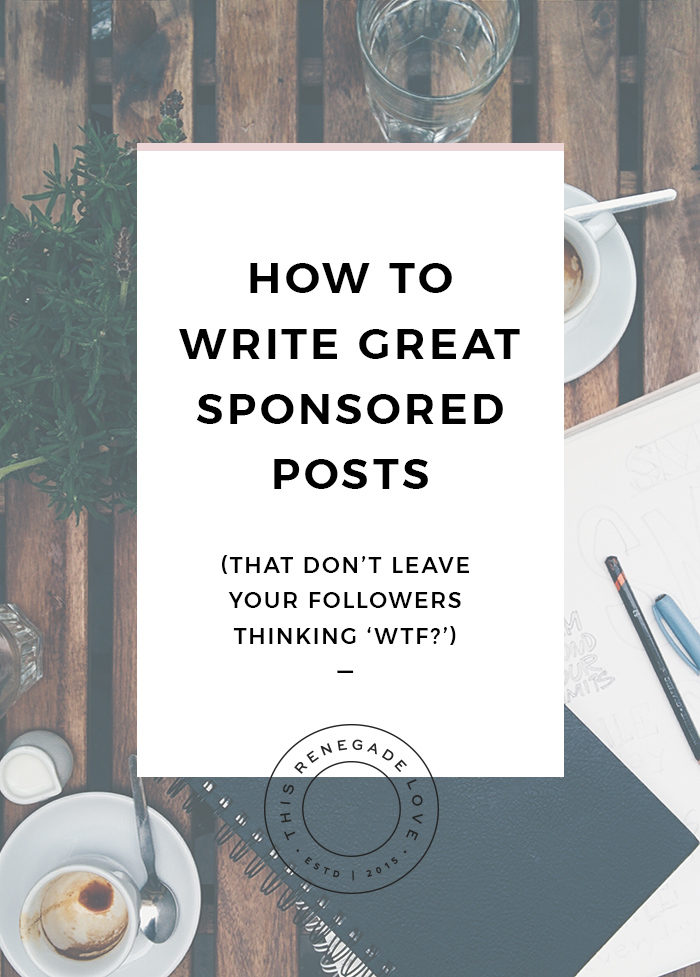
(photo by Eryn Shea Photography)
I can vividly remember the very first sponsored post I did for This Renegade Love back in 2015.
I’d only been blogging for 6 months, and was so excited that a brand was actually willing to pay me to talk about them. I grossly undercharged (because we alllllll do when we’re starting out), and didn’t even think to negotiate because I was just so thrilled by the opportunity and was terrified that they’d change their minds if I was anything but completely agreeable (sweet, sweet naive little Lauren). The post took me ages to write because I was so concerned about pleasing the client, using more of their language than my own, then stressed dafuq out when it didn’t perform as well as my other content. I quickly learned that my readers could sense when content was done for the money rather than created to benefit them.
As more sponsored opportunities presented themselves, I quickly learned that I needed to create rules for myself and a process when it came to branded content. Because working on sponsored content is HARD AF – it takes more thought, consideration and is fragile territory. As a content creator who makes money from brand partnerships, you constantly have to walk the line of pleasing the client, and at the same time, maintaining the integrity of your brand and respecting your community. As I learned from that first experience, I tried too hard to please the client, which came at the cost of pleasing my community.
If you find yourself struggling to create sponsored posts, here are the six steps I go through to make sure I’m creating awesome branded content that reflects my brand, meets the client’s objectives and (most importantly) respects my community.
___________

___________
Step 1: Only Partner With Brands That Are a Fit
This is step number one for a reason, and pretty much the most important one – this is where you determine whether or not the brand approaching you is a good match. Do you use the brand already? Is the product offering something your community is used to hearing you talk about? Do the brand’s core values mirror your personal brand values? At the end of the day, the content of your sponsored post shouldn’t come as a surprise to your community or leave them wondering why you’re sharing – it should blend in seamlessly to your original content. A fitness YouTuber talking about KFC’s new chicken sandwich or a fashion blogger posting about cold medicine… seems weird, right? Talking about something you don’t actually use or doesn’t reflect your brand is not only going to be super hard to do, but it will end up alienating your audience – the opposite of what you want a sponsored post to do. It might be hard to decline a big ol’ budget, but the pay day is never worth risking your brand’s reputation or losing your community.
___________
Step 2: Choose Your Best Storytelling Medium
Okee doke, so now that you’ve determined the brand is a good fit for your personal brand and community, consider how the campaign would best be shared with your audience. Whilst some brands have defined terms (they specifically want an Instagram post), many will give you a budget and ask what content you can offer for that amount or look to your insight on what platform would work best for the campaign. Consider how you can most authentically tell the story of the brand and their offering – is writing your strong suit, or do you come off more genuine with video? Is a styled Instagram photo best for sharing a new makeup palette, or would a YouTube tutorial tell a better story? Would a Facebook Live with an accountant be a better way to engage your community in a chat about tax season than a blog post Q & A? You know your audience best, so if the client is asking for something that you know isn’t going to resonate, suggest an alternative with a bigger pay-off for them and that best benefits your community.
___________
___________
Step 3: Ask For All the Details Up Front
You’ve got the content ask sorted, but before you sign on that dotted line, make sure you know all the requirements of the partnership and key messaging in advance. There’s nothing worse (trust) than signing on for a campaign, and a week later having a client present all these expectations that are major red flags to you. When a contract is presented to you for a campaign, it’s not the final word – this is your opportunity to negotiate and make sure the partnership is aligned with your needs as well as the client’s. If something sticks out as a red flag (the client wants you to use an excessive amount of hashtags, include specific and stiffly-written wording from the brand, publish three Insta posts in one week, etc), voice your concerns and negotiate the terms of the contract. At the end of the day, you’re looking out for the best interests of your community and personal brand.
Here are a few things you’ll want included in the contract or clarified by the brand before signing the dotted line:
- which campaign hashtags to use
- whether or not packaging needs to be present in the photo
- key messages for the campaign
- the proper name and spelling of the brand/product
- if they want a link in your bio (in which you can charge an additional fee)
- if they want exclusivity from working with competitors and how long for (in which you can charge an additional fee)
___________
Step 4: Come up with a story, then add the brand.
Contract signed, you’re officially a brand partner – now it’s time to actually create the content. A good sponsored post should feel organic and natural to your audience, and when there’s too much brand messaging, it can come off stiff and inauthentic. And THIS is where a lot of people get stuck. We tend to focus on fitting in all the messaging the brand presents to us and then have no room for our personality. Instead, try looking at the overall campaign objective or one key message, and think of how this directly ties in to your brand purpose or your personal life. Think of how that product solves a problem that your readers might have, or how it can enrich their lives, using anecdotes of how it’s done the same for you. Once you’ve written your story, then add the specific brand messaging into it.
I always think that the best sponsored posts are the ones where people don’t even know it’s sponsored until you get to the end and see that little #ad – that they’re so engaging and authentic and have so much of YOU in it, that it just blends in seamlessly with all of your other content. Which leads to the next step…
___________
Step 5: Write in your own voice.
Have you ever seen those sponsored posts that look like they’ve been written by the brand themselves, chock full of key messaging and corporate speak? Cringe. Your audience needs to trust that your opinion of the brand/product you’re sharing is really your own, which is why it’s so important to create the content in your own voice.
To avoid sounding like a robot, I usually imagine how I would text a friend to tell them about something I love. Am I going to say ,”This is the most innovative waterproof mascara on the market and I just love the way it takes my lashes to voluminous new lengths”? Probably most definitely not ever. I’m more likely to say, “Remember that time I jumped in the pool at your bachelorette and emerged looking like a crazed raccoon? Haha – MORTIFYING. Finally found a waterproof mascara by Smashbox that ACTUALLY works, so you bettah believe I’ll be bathing my lashes in it all summer. SO. GOOD.” The next time you sit to write a sponsored post, grab your phone and pretend to be texting a friend about the product/service – it’s a simple concept, but really works if you have a hard time injecting your personality into branded content.
And if you’re really not strong with writing, think of how you can tell the story with your visuals. Instead of writing about the mascara, share a before and after picture to show the results.
___________
Step 6: Encourage discussion.
Finally, a great sponsored post should always aim to encourage participation from your community because the only reason you should be doing branded content is to benefit your readers (NOT because you want a pay cheque). Lead the post with a question that gets them intrigued from the get-go, like “How many of you cry every time tax season rolls around?” for a sponsored post about mobile accounting, or “When was the last time you actually enjoyed a workout?” for branded content for a new gym (ending the post with a question is also effective). The goal is to get them to continue the discussion of what you’re sharing, whether it’s their own personal experiences or their thoughts on the brand itself.
And of course, always be transparent with your community if the content has been sponsored or is in partnership with a brand – there’s nothing worse than losing your readers’ trust by not disclosing the terms of your content.
___________
What’s your biggest struggle when creating a sponsored post?
What kind of sponsored posts make you cringe?
Who’s doing sponsored content really well?
Share your thoughts in the comments below!

Such an informative post Lauren. I actually just left you a comment on Instagram before I read the blog post and wow, yeah we are pretty much on the same page!
Haha yes, I saw your comment and we’re definitely on that same wavelength! 🙂 <3
This is just what I needed to read! I always undervalue myself and today I sent off an email with my fee to a brand that was higher than I normally would charge, thanks to you. These are some amazing tips, as it can be hard to know how to write a relatable post about a brand. Thank you!
What has worked for me is trying to incorporate a product into a personal post or story so that it relates to my actual life. I also only work with brands that I am a fan of and would actually pay for myself. That way it is more authentic and fun to write about. I think that is key!
One of my fav bloggers who does some fantastic sponsored content is Jules Williams from http://www.thisisjules.com. She is always consistent and working with brands she already loves. She definitely knows what her readers want 🙂
Cheers Jules!! And thanks so much for introducing me to thisisjules.com – hadn’t heard of her before!
This post came at such a timely point for me! I’ve recently been doing small sponsored posts for the first time and these were great tips. The bit about pretending to text a friend is such a great idea. Definitely going to try it out for my next sponsored post. Thanks so much for the insight!
Honestly, it’s such a simple but effective thing. I think that’s where most of us get stuck, is actually writing like a human, whilst still incorporating key messages.
Thanks for sharing all of this information! It’s so incredibly useful and I’m sure many of those just starting out appreciate it – I know I do! 🙂
No worries Michelle – happy to help out whenever I can 🙂
This article is so insightful. Being a baby blogger, haha with a blog less than a year old, your posts answer questions that a lot of us are afraid to ask. Thanks for spilling your secrets. Keep it up!
Awesome Luisa! So happy that this could offer a little insight into the world of sponsored content 🙂
I appreciate this post. Great useful tips and I am planning to use them for all my future sponsored post. Thank you.
Great post! Too often, people try to snag sponsored posts for things that are so far from their niche… Yep, sticking with what fits AND what you can be passinate about is a must for a high-quality post. ????????
This is super helpful, thank you! I just had a request for my first sponsored post, and your article is immensely helpful:)
Thank you very much, you just introduced me to a liable means of making more from blogging, I can’t really thank you enough for such great insight.
Thanks again.
[…] If a post provides little value to the reader, it will quickly get buried by new content and disappear. Just read this blogger’s perspective on how sponsored posts written like advertisements fail miserably. […]
[…] Sponsored posts promoting a specific product or service are a great way to earn a reliable income from your blog. […]